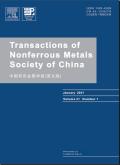采用自旋镀膜法制备了一种用于电解和光电探测器的铁掺杂ZnO薄膜
IF 4.7
1区 材料科学
Q1 METALLURGY & METALLURGICAL ENGINEERING
Transactions of Nonferrous Metals Society of China
Pub Date : 2025-04-01
DOI:10.1016/S1003-6326(24)66747-6
引用次数: 0
摘要
研究了铁浓度对电解和光电探测器用氧化锌微结构和结构性能的影响。采用自旋镀膜的方法在玻璃衬底上沉积了不同铁含量(2、4和6 wt.%)的未掺杂和掺杂ZnO薄层。通过x射线衍射(XRD)、原子力显微镜(AFM)、扫描电镜(SEM)、能量色散x射线能谱(EDS)、紫外-可见吸收光谱和x射线光电子能谱(XPS)对样品进行了表征。XRD结构测量表明,所有层均由六方纤锌矿结构的多晶组成。掺杂后还发现了两个新的峰,分别属于Fe2O4(400)和Fe2O4(440)晶相。形貌分析表明,ZnO层的表面粗糙度值在8 ~ 45 nm之间。XPS研究证实了氧化锌层中存在3+态的铁。在200 ~ 900 nm波长范围内,用UV - Vis测得的平均透过率为90%。能隙(Eg)随Fe浓度的增加而减小。AFM形貌结果证实zno基薄层具有相对均匀的表面。这些样品的效率已被证实用于许多电气应用,包括光电探测器和污染溶液的电解。本文章由计算机程序翻译,如有差异,请以英文原文为准。
Thin layers of Fe-doped ZnO deposited by spin-coating for electrolysis and photodetector applications
The effect of iron concentration on the microstructural and structural properties of ZnO for electrolysis and photodetector applications was investigated. The thin layers of un-doped and doped ZnO with different percentages of Fe (2, 4, and 6 wt.%) were deposited by spin-coating on glass substrates. Sample characterization was done by X-ray diffraction (XRD), atomic force microscopy (AFM), scanning electron microscopy (SEM), energy-dispersive X-ray spectroscopy (EDS), UV−Vis absorption spectra and X-ray photoelectron spectroscopy (XPS). Structural measurements by XRD showed that all the layers were composed of polycrystallines with a hexagonal Wurtzite structure. Two new peaks were also discovered after the doping process belonging to the Fe2O4 (400) and (440) crystal phase. Morphological analysis showed that the surface roughness values of ZnO layers ranged between 8 and 45 nm. XPS studies confirmed the presence of Fe in 3+ states in ZnO layers. An average transmittance of 90% was measured by UV−Vis in the wavelength range of 200−900 nm. The values of the energy gap (Eg) decreased with an increase in the concentration of Fe. AFM topography results confirmed that ZnO-based thin layers had a relatively uniform surface. The efficiency of these samples has been confirmed for their use in many electrical applications, including photodetectors and electrolysis of contaminated solutions.
求助全文
通过发布文献求助,成功后即可免费获取论文全文。
去求助
来源期刊
CiteScore
7.40
自引率
17.80%
发文量
8456
审稿时长
3.6 months
期刊介绍:
The Transactions of Nonferrous Metals Society of China (Trans. Nonferrous Met. Soc. China), founded in 1991 and sponsored by The Nonferrous Metals Society of China, is published monthly now and mainly contains reports of original research which reflect the new progresses in the field of nonferrous metals science and technology, including mineral processing, extraction metallurgy, metallic materials and heat treatments, metal working, physical metallurgy, powder metallurgy, with the emphasis on fundamental science. It is the unique preeminent publication in English for scientists, engineers, under/post-graduates on the field of nonferrous metals industry. This journal is covered by many famous abstract/index systems and databases such as SCI Expanded, Ei Compendex Plus, INSPEC, CA, METADEX, AJ and JICST.

 求助内容:
求助内容: 应助结果提醒方式:
应助结果提醒方式:


